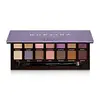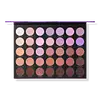What's inside
What's inside
 Key Ingredients
Key Ingredients

 Benefits
Benefits

 Concerns
Concerns

 Ingredients Side-by-side
Ingredients Side-by-side

Mica
Cosmetic ColorantSynthetic Fluorphlogopite
Calcium Sodium Borosilicate
Silica
AbrasiveDimethicone
EmollientBoron Nitride
AbsorbentNylon-12
Zinc Stearate
Cosmetic ColorantCyclopentasiloxane
EmollientGlycerin
HumectantPolymethylsilsesquioxane
Vinyl Dimethicone/Methicone Silsesquioxane Crosspolymer
Zea Mays Starch
AbsorbentZinc Myristate
Caprylyl Glycol
EmollientHydrogenated Lecithin
EmulsifyingIsopentyldiol
HumectantLauroyl Lysine
Skin ConditioningPhenoxyethanol
PreservativePolysilicone-11
Tin Oxide
AbrasiveTocopherol
AntioxidantCI 19140
Cosmetic ColorantCI 75470
Cosmetic ColorantIron Oxides
CI 77891
Cosmetic ColorantOctyldodecyl Stearoyl Stearate
EmollientBeeswax
Emulsion StabilisingSodium Polyacrylate
AbsorbentTheobroma Cacao Seed Butter
EmollientCI 77400
Cosmetic ColorantAluminum Calcium Sodium Silicate
Calcium Aluminum Borosilicate
Triethoxycaprylylsilane
Paraffinum Liquidum
EmollientCI 16035
Cosmetic ColorantCI 77491
Cosmetic ColorantPolyethylene Terephthalate
Acrylates Copolymer
Polyurethane-11
Epoxy Resin Coated Aluminum Powder
Cosmetic ColorantCI 77266
Cosmetic ColorantCI 77510
Cosmetic ColorantCI 77007
Cosmetic ColorantCI 77163
Cosmetic ColorantCI 77742
Cosmetic ColorantBlue 1 Lake
Cosmetic ColorantMica, Synthetic Fluorphlogopite, Calcium Sodium Borosilicate, Silica, Dimethicone, Boron Nitride, Nylon-12, Zinc Stearate, Cyclopentasiloxane, Glycerin, Polymethylsilsesquioxane, Vinyl Dimethicone/Methicone Silsesquioxane Crosspolymer, Zea Mays Starch, Zinc Myristate, Caprylyl Glycol, Hydrogenated Lecithin, Isopentyldiol, Lauroyl Lysine, Phenoxyethanol, Polysilicone-11, Tin Oxide, Tocopherol, CI 19140, CI 75470, Iron Oxides, CI 77891, Octyldodecyl Stearoyl Stearate, Beeswax, Sodium Polyacrylate, Theobroma Cacao Seed Butter, CI 77400, Aluminum Calcium Sodium Silicate, Calcium Aluminum Borosilicate, Triethoxycaprylylsilane, Paraffinum Liquidum, CI 16035, CI 77491, Polyethylene Terephthalate, Acrylates Copolymer, Polyurethane-11, Epoxy Resin Coated Aluminum Powder, CI 77266, CI 77510, CI 77007, CI 77163, CI 77742, Blue 1 Lake
Talc
AbrasiveMica
Cosmetic ColorantSilica
AbrasiveMagnesium Stearate
Cosmetic ColorantHydrogenated Polyisobutene
EmollientDimethicone
EmollientBoron Nitride
AbsorbentOctyldodecyl Stearoyl Stearate
EmollientPhenoxyethanol
PreservativeBis-Diglyceryl Polyacyladipate-2
EmollientVinyl Dimethicone/Methicone Silsesquioxane Crosspolymer
Tocopheryl Acetate
AntioxidantWater
Skin ConditioningHydroxyacetophenone
AntioxidantCaprylyl Glycol
EmollientSynthetic Fluorphlogopite
Stearic Acid
CleansingEthylhexylglycerin
Skin ConditioningKaolin
AbrasiveTriethoxycaprylylsilane
Tocopherol
AntioxidantCI 77891
Cosmetic ColorantIron Oxides
CI 77742
Cosmetic ColorantCI 77007
Cosmetic ColorantCI 19140
Cosmetic ColorantCI 42090
Cosmetic ColorantMaltodextrin
AbsorbentCI 75470
Cosmetic ColorantCI 77510
Cosmetic ColorantLauroyl Lysine
Skin ConditioningCI 16035
Cosmetic ColorantEthylhexyl Palmitate
EmollientIsononyl Isononanoate
EmollientPhenyl Trimethicone
Skin ConditioningTridecyl Trimellitate
EmollientIsopropyl Isostearate
EmollientCalcium Sodium Borosilicate
Tin Oxide
AbrasiveAmethyst Powder
AbrasiveCopper PCA
HumectantViola Odorata Flower Extract
MaskingHdi/Trimethylol Hexyllactone Crosspolymer
CI 15985
Cosmetic ColorantCI 15850
Cosmetic ColorantCI 45410
Cosmetic ColorantTalc, Mica, Silica, Magnesium Stearate, Hydrogenated Polyisobutene, Dimethicone, Boron Nitride, Octyldodecyl Stearoyl Stearate, Phenoxyethanol, Bis-Diglyceryl Polyacyladipate-2, Vinyl Dimethicone/Methicone Silsesquioxane Crosspolymer, Tocopheryl Acetate, Water, Hydroxyacetophenone, Caprylyl Glycol, Synthetic Fluorphlogopite, Stearic Acid, Ethylhexylglycerin, Kaolin, Triethoxycaprylylsilane, Tocopherol, CI 77891, Iron Oxides, CI 77742, CI 77007, CI 19140, CI 42090, Maltodextrin, CI 75470, CI 77510, Lauroyl Lysine, CI 16035, Ethylhexyl Palmitate, Isononyl Isononanoate, Phenyl Trimethicone, Tridecyl Trimellitate, Isopropyl Isostearate, Calcium Sodium Borosilicate, Tin Oxide, Amethyst Powder, Copper PCA, Viola Odorata Flower Extract, Hdi/Trimethylol Hexyllactone Crosspolymer, CI 15985, CI 15850, CI 45410
Ingredients Explained
These ingredients are found in both products.
Ingredients higher up in an ingredient list are typically present in a larger amount.
Boron Nitride is compound consisting of boron and nitrogen. It is used to absorb oil and modify adherence/ slip in products.
This means it is often used in makeup products to help them last longer.
Calcium Sodium Borosilicate is a bulking agent. It is considered a borosilicate glass; it is composed of powder or flakes of calcium and sodium borosilicates.
This ingredient is used to add volume, shine, and color to products. You'll most likely find this ingredient in makeup products.
According to in-vivo and ex-vivo studies done by a manufacturer, this ingredient works well with UV filters:
Learn more about Calcium Sodium BorosilicateCaprylyl Glycol is a humectant and emollient, meaning it attracts and preserves moisture.
It is a common ingredient in many products, especially those designed to hydrate skin. The primary benefits are retaining moisture, skin softening, and promoting a healthy skin barrier.
Though Caprylyl Glycol is an alcohol derived from fatty acids, it is not the kind that can dry out skin.
This ingredient is also used as a preservative to extend the life of products. It has slight antimicrobial properties.
Learn more about Caprylyl GlycolCi 16035 is a synthetic dark-red dye. This dye is created from an acid called Allura red AC, an azo dye.
Azo dyes need to be purified thoroughly before use. This makes them more stable and longer lasting.
This dye is commonly used in foods, approved by both the FDA and EFSA.
Learn more about CI 16035CI 19140 is also known as Tartrazine. Tartrazine is a synthetic dye used in cosmetics, foods, and medicine to add a yellow color.
Tartrazine is created from petroleum and is water-soluble.
Some people may experience allergies from this dye, especially asthmatics and those with an aspirin intolerance.
Learn more about CI 19140Ci 75470 is a bright-red pigment. It is AKA carmine.
Carmine is derived from insects such as the cochineal beetle. This ingredient has been used as a natural dye for over 2000 years.
This pigment is called Ultramarine blue lazurite. It gives a saturated blue color, but can be used to create other colors as well.
According to the manufacturer, it is usually made from kaolin, sodium sulfate, sodium carbonate, sulfur, and charcoal.
This ingredient is used to impart a blue color. It is not water-soluble.
It goes by two different names:
1. Ferric Ferrocyanide: a synthetic dark blue pigment
2. Ferric Ammonium Ferrocyanide: a synthetic blue pigment, also called Prussian blue
In the EU, both of these colors must be labeled as 'CI 77510'.
Learn more about CI 77510This ingredient is used to add a violet color to cosmetics.
It is created by reacting phosphoric acid, ammonium dihydrogen orthophosphate, and manganese dioxide.
Ci 77891 is a white pigment from Titanium dioxide. It is naturally found in minerals such as rutile and ilmenite.
It's main function is to add a white color to cosmetics. It can also be mixed with other colors to create different shades.
Ci 77891 is commonly found in sunscreens due to its ability to block UV rays.
Learn more about CI 77891Dimethicone is a type of synthetic silicone created from natural materials such as quartz.
What it does:
Dimethicone comes in different viscosities:
Depending on the viscosity, dimethicone has different properties.
Ingredients lists don't always show which type is used, so we recommend reaching out to the brand if you have questions about the viscosity.
This ingredient is unlikely to cause irritation because it does not get absorbed into skin. However, people with silicone allergies should be careful about using this ingredient.
Note: Dimethicone may contribute to pilling. This is because it is not oil or water soluble, so pilling may occur when layered with products. When mixed with heavy oils in a formula, the outcome is also quite greasy.
Learn more about DimethiconeThis ingredient comes from a fatty acid (lauric acid) and amino acid (lysine). It is used to add a silky feel to cosmetics.
According to a manufacturer, its fatty acid base leaves a silky feeling on the skin. It also has emollient properties because of this. Emollients help soften skin by preventing water from evaporating.
Lauroyl lysine is barely soluble in water.
Learn more about Lauroyl LysineMica is a naturally occurring mineral used to add shimmer and color in cosmetics. It can also help improve the texture of a product or give it an opaque, white/silver color.
Serecite is the name for very fine but ragged grains of mica.
This ingredient is often coated with metal oxides like titanium dioxide. Trace amounts of heavy metals may be found in mica, but these metals are not harmful in our personal products.
Mica has been used since prehistoric times throughout the world. Ancient Egyptian, Indian, Greek, Roman, Aztec, and Chinese civilizations have used mica.
Learn more about MicaOctyldodecyl Stearoyl Stearate is created from stearic acid.
It is an emollient and thickens the lipid (oil) portion of a product. Due to its emollient properties, it may not be fungal-acne safe.
Phenoxyethanol is a preservative that has germicide, antimicrobial, and aromatic properties. Studies show that phenoxyethanol can prevent microbial growth. By itself, it has a scent that is similar to that of a rose.
It's often used in formulations along with Caprylyl Glycol to preserve the shelf life of products.
Silica, also known as silicon dioxide, is a naturally occurring mineral. It is used as a fine, spherical, and porous powder in cosmetics.
Though it has exfoliant properties, the function of silica varies depending on the product.
The unique structure of silica enhances the spreadability and adds smoothness, making it a great texture enhancer.
It is also used as an active carrier, emulsifier, and mattifier due to its ability to absorb excess oil.
In some products, tiny microneedles called spicules are made from silica or hydrolyzed sponge. When you rub them in, they lightly polish away dead skin layers and enhance the penetration of active ingredients.
Learn more about SilicaSynthetic Fluorphlogopite is the synthethic version of mica. It consists of fluorine, aluminum and silicate.
Synthetic Fluorphlogopite is used to add volume to products.
It is considered non-irritating on the skin.
Learn more about Synthetic FluorphlogopiteTin Oxide is an inorganic oxide used to add opacity and volume to a product. In nature, it is already found in mineral form. The main ore of tin is an opaque and shiny mineral called casseterite.
Tin Oxide helps remove translucency in a product, or make it more opaque. Besides adding opacity, tin oxide is used for bulking to add volume.
Tocopherol (also known as Vitamin E) is a common antioxidant used to help protect the skin from free-radicals and strengthen the skin barrier. It's also fat soluble - this means our skin is great at absorbing it.
Vitamin E also helps keep your natural skin lipids healthy. Your lipid skin barrier naturally consists of lipids, ceramides, and fatty acids. Vitamin E offers extra protection for your skin’s lipid barrier, keeping your skin healthy and nourished.
Another benefit is a bit of UV protection. Vitamin E helps reduce the damage caused by UVB rays. (It should not replace your sunscreen). Combining it with Vitamin C can decrease sunburned cells and hyperpigmentation after UV exposure.
You might have noticed Vitamin E + C often paired together. This is because it is great at stabilizing Vitamin C. Using the two together helps increase the effectiveness of both ingredients.
There are often claims that Vitamin E can reduce/prevent scarring, but these claims haven't been confirmed by scientific research.
Learn more about TocopherolTriethoxycaprylylsilane is a silicone used to bind and stabilize ingredients.
As an emulsifier, it helps prevent ingredients from separating. This can help elongate the shelf life of products.
Triethoxycaprylylsilane is often used to coat mineral sunscreens ingredients to help give a better feel. It also helps reduce oxidative stress in sunscreens.
Learn more about TriethoxycaprylylsilaneThis ingredient is used in makeup and skincare to thicken formulas, reduce shine, and give skin a silky-smooth feel.
It’s a white silicone powder that sits in fine lines and pores to blur their appearance though its effectiveness depends on the particle size.
You'll typically find this ingredient in amounts between 0.1-20%.
Learn more about Vinyl Dimethicone/Methicone Silsesquioxane CrosspolymerThis ingredient is a combination of red, black, and yellow iron oxide pigments. This combination of colors is usually found in foundation, because it results in a "skin" color.